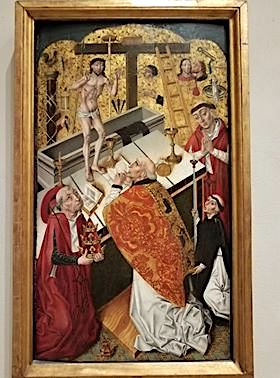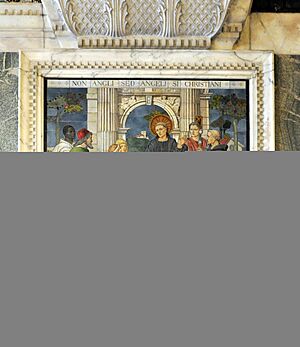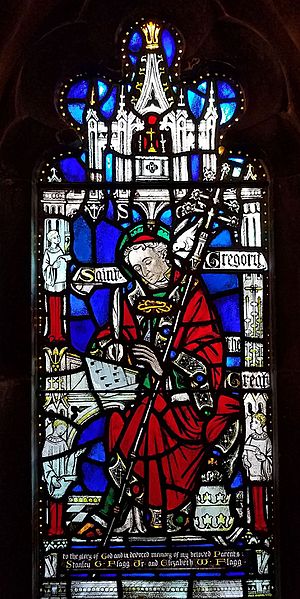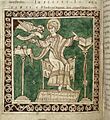Pope Gregory I facts for kids
Quick facts for kids Gregory I |
|
|---|---|
| Bishop of Rome | |
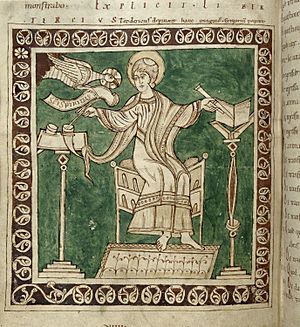
Miniature of Gregory the Great writing, in a 12th-century copy of his Dialogues, British Library, London.
|
|
| Church | Catholic Church |
| Papacy began | 3 September 590 |
| Papacy ended | 12 March 604 |
| Predecessor | Pelagius II |
| Successor | Sabinian |
| Orders | |
| Consecration | 3 September 590 |
| Personal details | |
| Birth name | Gregorius Anicius |
| Born | c. 540 Rome, Eastern Roman Empire |
| Died | 12 March 604 (aged 63–64) Rome, Eastern Roman Empire |
| Buried | St. Peter's Basilica (1606) |
| Residence | Rome |
| Parents | Gordianus and Silvia |
| Sainthood | |
| Feast day |
|
| Venerated in | |
| Attributes | |
| Patronage | Musicians, singers, students, and teachers |
| Other Popes named Gregory | |
Pope Gregory I (born around 540 – died March 12, 604), often called Saint Gregory the Great, was the leader of the Catholic Church in Rome from September 3, 590, until his death. He is famous for starting the first big mission from Rome. This mission, called the Gregorian mission, aimed to convert the pagan Anglo-Saxons in England to Christianity.
Gregory is also known for his many writings. He wrote more than any other pope before him. In Eastern Christianity, he is sometimes called Saint Gregory the Dialogist because of his book Dialogues.
Before becoming pope, Gregory was a Roman senator's son and even the prefect of Rome (a top city official) by age 30. He lived in a monastery he built on his family's land. His political experience helped him become a skilled leader. As pope, he greatly improved the lives of people in Rome. He also sent missionaries like Augustine of Canterbury to England. Gregory helped bring many groups like the Franks and Lombards closer to Rome and the Catholic faith.
People in the Middle Ages called him "the Father of Christian Worship." This was because he worked hard to improve the way people worshipped in Rome. He also helped shape the Divine Liturgy of the Presanctified Gifts, which is still used today in some churches. Gregory is considered one of the important Latin Fathers and a Doctor of the Church. He is a saint in many Christian churches. He is the patron saint of musicians, singers, students, and teachers.
Contents
Early Life and Family
Gregory was born around 540 in Rome. At this time, the Eastern Roman Empire had recently taken Rome back from the Ostrogoths. His parents named him Gregorius, which means "Watchful" in English.
Gregory came from a rich and important Roman family. His father, Gordianus, was a senator and once the Prefect of Rome. Gregory's mother, Silvia, was also from a good family. Both his mother and two aunts are honored as saints. Gregory's great-great-grandfather was even a pope, Pope Felix III.
His family lived in a large house on the Caelian Hill in Rome. They also owned farms in Sicily and near Rome. Gregory was born during a difficult time in Italy. A terrible sickness called the Plague of Justinian spread in 542. This caused hunger and fear. The city of Rome was also attacked and emptied in 546 by Totila. Young Gregory and his family might have moved to their farms in Sicily during this time.
Like other young men from wealthy families, Gregory received a good education. He studied grammar, public speaking, science, literature, and law. He was very good at all of them. He became a government official and quickly rose in rank. By age 33, he was the Prefect of Rome, the city's highest civil office.
Becoming a Monk
After his father died, Gregory turned his family's large house into a monastery. It was dedicated to Andrew the Apostle. He loved the quiet life of prayer and thinking. Gregory believed that being a monk meant a "strong search for the vision of our Creator."
He had great respect for the monastic life and for being poor. Gregory's three aunts were nuns known for their holiness. However, one of them later left the religious life and married. Gregory's mother, Silvia, is also a saint.
Later, Pope Pelagius II made Gregory a deacon. He asked Gregory to help heal a split in the church in northern Italy.
Serving as Ambassador
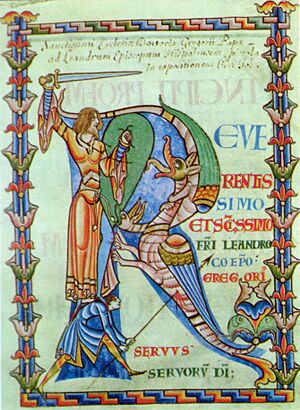
In 579, Pope Pelagius II chose Gregory to be his apocrisiarius. This meant he was the pope's ambassador to the emperor's court in Constantinople. Gregory held this job until 586. His main task was to ask the emperor for military help against the Lombards, who were attacking Rome.
However, the emperor was busy fighting wars in other places. It became clear that the Byzantine emperors would not send help to Italy. Gregory then focused on making friends with important people in Constantinople. He became very popular with the city's wealthy families.
Gregory returned to his monastery in Rome in 585. In 590, Pope Pelagius II died from the plague. Gregory was then chosen by everyone to become the new pope. He was approved by the emperor in Constantinople later that year.
Gregory's Time as Pope
When Gregory became pope in 590, he was not eager for the job. He preferred the quiet life of a monk. He wrote letters saying he did not want to be pope and praised the peaceful life of prayer.
The Church in Rome had not been very strong in leading the Western world for a long time. Italy was also suffering from attacks by the violent Lombards. The government in Constantinople was far away and could not help much.
Pope Gregory strongly believed in missionary work. He said that God puts good people in charge to help others. He is famous for sending a mission, called the Gregorian mission, to England. This mission, led by Augustine of Canterbury, aimed to convert the Anglo-Saxons to Christianity. Gregory had seen English slaves in Rome and felt a strong desire to help their people. The mission was very successful. From England, missionaries later went to other parts of Europe.
Gregory also worked to make sure Christian faith was taught correctly. He wanted to remove any wrong ideas. He was declared a saint right after his death by popular demand. Gregory was also the first pope to widely use the title "Servant of the Servants of God" (servus servorum Dei). This title is still used by popes today.
Helping the Poor
The Church had a long tradition of giving money and goods to the poor. As pope, Gregory made sure this continued. He is known for creating a large system to help the poor in Rome. Many poor people were refugees who had fled from the Lombards. Gregory believed that the Church's wealth belonged to the poor, and the Church was just managing it.
Wealthy Roman families gave many donations to the Church. Gregory used these donations to help people. He wrote to his helpers, telling them to "act as my representative... to relieve the poor in their distress." He saw himself as a "steward to the property of the poor."
In Gregory's time, Rome was in ruins. The Lombards controlled most of Italy. The economy had stopped, and the city was full of refugees. People were hungry and had little. Gregory could not wait for help from Constantinople.
In 590, Gregory organized the Church's resources to provide general relief. He was very good at managing things. The Church kept careful records of all its spending and income. Gregory demanded that his churchmen find and help needy people. He replaced those who did not cooperate.
He understood that he needed enough income to cover his expenses. So, he sold some Church property and used the money. He also made sure the Church's farms, called patrimonia, sent food to Rome. Grain, wine, cheese, meat, fish, and oil arrived in large amounts. This food was given away for free to the poor.
Food was given out monthly to those who qualified. For those too sick or weak to pick up food, Gregory sent monks and other helpers every morning with prepared meals. It is said he would not eat until the poor were fed. He even cooked meals himself for needy people in wealthy homes, so they would not feel ashamed. Gregory's kindness won the hearts of the Roman people. They began to look to the pope for leadership, not the government in Constantinople.
Important Works
Changes to Worship
Gregory I made many changes to the way church services were held. He moved the Pater Noster (Our Father) to a new place in the Mass. This position is still used today in the Roman Catholic Church. He also added parts to the Hanc Igitur and started the nine Kyries at the beginning of Mass.
In the Eastern Orthodox Church and Eastern Catholic Churches, Gregory is seen as the main person who created the Divine Liturgy of the Presanctified Gifts. This special service is used during Great Lent, a time of fasting and prayer.
Gregorian Chant
The main type of Western plainchant, which became standard in the late 800s, was named after Pope Gregory I. The first time it was linked to him was in a biography written in 873, almost 300 years after his death. This chant is a mix of Roman and Frankish styles.
Writings
Gregory is often seen as the founder of the medieval papacy. This means he helped shape the role of the pope in the Middle Ages. He is the only pope from the 5th to 11th centuries whose letters and writings have largely survived. Some of his important writings include:
- Moralia in Job: This is one of the longest works by early Church leaders. It is based on talks Gregory gave about the Book of Job.
- Pastoral Care (Liber regulae pastoralis): In this book, he described the role of bishops as shepherds of their people.
- Dialogues: This is a collection of four books about miracles and healings by holy men in Italy. The second book is all about the life of Saint Benedict.
- Sermons: These include Homilies on Ezekiel and Forty Homilies on the Gospels.
- Over 850 letters: These letters give us a clear picture of his work during his 13 years as pope.
Famous Sayings and Stories
- Non Angli, sed angeli, si forent Christiani. – "They are not Angles, but angels, if they were Christian." This famous saying is about when Gregory saw pale-skinned English boys at a slave market. He said they had "angelic faces" and should be Christians. This led him to send St. Augustine to England to convert the English people.
- "I beg that you will not take the present amiss. For anything, however trifling, which is offered from the prosperity of St. Peter should be regarded as a great blessing, seeing that he will have power both to bestow on you greater things, and to hold out to you eternal benefits with Almighty God."
- "Whoever calls himself universal bishop, or desires this title, is, by his pride, the precursor to the Antichrist."
- Non enim pro locis res, sed pro bonis rebus loca amanda sunt – "Things are not to be loved for the sake of a place, but places are to be loved for the sake of their good things." When Augustine asked whether to use Roman or Gallican customs in the Mass in England, Gregory said it was more important to please God. They should choose what was "pious," "religious," and "right" from any church.
- "Illiterate men can contemplate in the lines of a picture what they cannot learn by means of the written word." This means that people who cannot read can learn from pictures.
- Age quod agis – "Do what you are doing." This became a saying for Catholic mystics, encouraging people to focus on serving God.
- "Repentance is weeping for what one has done and not doing what one weeps for."
Memorials and Feast Day
Relics
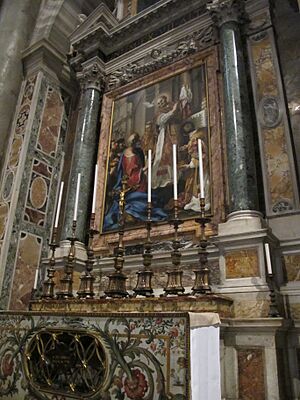
The remains of Saint Gregory are kept in St. Peter's Basilica in Rome.
Lives and Monuments
In Britain, people greatly admired Gregory even after his death. The first full story of his life was written there around 713. The church of San Gregorio al Celio in Rome remembers his work. One of its chapels is said to be over the tomb of Gregory's mother. In England, Gregory is honored as the apostle who helped convert the nation to Christianity.
Music
The Italian composer Ottorino Respighi wrote a piece called St. Gregory the Great. It is part of his Church Windows works.
Feast Day
The Catholic Church now celebrates Saint Gregory the Great on September 3. This is the day he became a bishop in 590. Before 1969, his feast day was March 12, the day he died. However, March 12 often falls during Lent, a time when many feasts are not fully celebrated. So, the date was changed.
The Eastern Orthodox Church and some Eastern Catholic Churches still remember Saint Gregory on March 12. This is during Great Lent, when the Divine Liturgy of the Presanctified Gifts, which Gregory is credited with, is used. Other churches, like the Lutheran Church–Missouri Synod and the Episcopal Church of the United States, also honor him on different dates.
A traditional parade is held in Żejtun, Malta, in honor of Saint Gregory on Easter Wednesday.
Images for kids
-
Miniature of Gregory the Great writing, in a 12th-century copy of his Dialogues, British Library, London.
-
Illumination in a 12th-century manuscript of a letter of Gregory's to Leander, bishop of Seville (Bibl. Municipale, MS 2, Dijon)
-
Saint Gregory the Great by José de Ribera
-
19th-century mosaic in Westminster Cathedral, Non Angli sed Angeli
-
Altar of Saint Gregory in St. Peter's Basilica, which contains the remains of Pope Gregory.
See also
 In Spanish: Gregorio Magno para niños
In Spanish: Gregorio Magno para niños
- Category:Documents of Pope Gregory I
- Libellus responsionum
- List of Catholic saints
- List of popes
- Pope Saint Gregory I, patron saint archive



